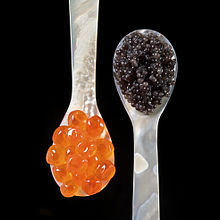
Back Kaviaar Afrikaans كافيار Arabic الكافيار ARZ Kürü Azerbaijani خاویار AZB Ікра ў кулінарыі Byelorussian Черен хайвер Bulgarian Caviar Catalan Ӏаьржа Ӏов CE Kaviár Czech
| Place of origin | Iran |
|---|---|
| Region or state | Black Sea region Sea of Azov region Caspian Sea region |


Caviar (also known as caviare, originally from Persian: خاویار, romanized: khâvyâr, lit. 'egg-bearing') is a food consisting of salt-cured roe of the family Acipenseridae. Caviar is considered a delicacy and is eaten as a garnish or spread.[1] Traditionally, the term caviar refers only to roe from wild sturgeon in the Caspian Sea and Black Sea[2] (beluga, ossetra and sevruga caviars). The term caviar can also describe the roe of other species of sturgeon or other fish such as paddlefish, salmon, steelhead, trout, lumpfish, whitefish,[3] or carp.[4]
The roe can be "fresh" (non-pasteurized) or pasteurized, which reduces its culinary and economic value.[5]
- ^ Goldstein, D. (1999). A Taste of Russia: A Cookbook of Russian Hospitality. Russian Life Books. p. 71. ISBN 978-1-880100-42-4. Retrieved 28 May 2017.
- ^ lan Davidson, Tom Jane, The Oxford companion to food, Oxford University Press, 2006, ISBN 0-19-280681-5, ISBN 978-0-19-280681-9, p. 150.
- ^ "Smith Bros. Whitefish Caviar". web44.net. Archived from the original on 4 January 2014.
- ^ Fodor, Alexandrina, et al. "ASSESSMENT OF DEGREE OF FRESHNESS AND QUALITY OF PRODUCTS TYPE "FISH ROE" SOLD IN SUPERMARKET CHAIN STORES." Analele Universităţii din Oradea, Fascicula: Ecotoxicologie, Zootehnie şi Tehnologii de Industrie Alimentară 10.A (2011): 177–181.
- ^ According to Jean-Pierre Esmilaire, Directeur Général of Caviar House & Prunier: "two-thirds of caviar's taste is lost through pasteurisation." (in "Three-star caviar", Caterersearch – The complete information source for hospitality, 1 February 2001).
© MMXXIII Rich X Search. We shall prevail. All rights reserved. Rich X Search